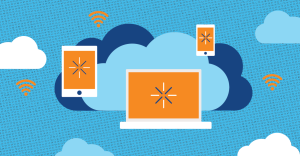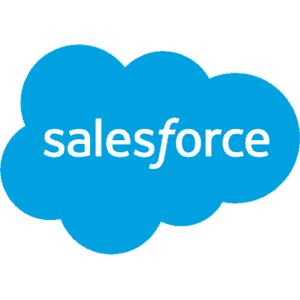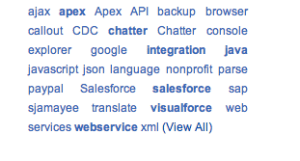Everything You Need to Understand Cloud Computing



Learn about the basics of cloud computing and why it’s a popular option for businesses of all sizes.

Salesforce Canada
Cloud computing is an advancement in technology that allows users to store and access data and programs over the internet instead of on a hard drive. It is more accessible and easier to use than traditional hardware, and it helps companies stay at the forefront of technology. One subset of cloud computing, cloud hosting, is another method to help companies that gives users the option of using virtual servers to provide hosting solutions.
With cloud computing, there are multiple types of services. Software as a Service (SaaS) programs include programs such as Salesforce, Google Apps, and GoToMeeting. Software is hosted on a remote server and is always accessible through an internet browser. For companies that need to create software, a Platform as a Service (PaaS) lets developers concentrate on software building without dealing with updates, operating systems, and storage. And Infrastructure as a Service (IaaS) delivers cloud computing infrastructure like servers, a network, and operating systems. Organizations can buy resources as a service on demand.
A Deeper Look into the Cloud
- What is cloud computing?
- Cloud computing means storing and accessing data and programs over the internet instead of your computer’s hard drive
- Delivers computing resources (hardware and software) over the internet
- Also described as an Internet Centric Software
- Benefits include:
- 24/7 access to data
- Works on any device
- Accessible from anywhere with an internet connection
- Automatic upgrades to the latest version
- Improved data liability and security
- Large collection of free software
- Only pay for what you use
- Faster deployments
- Subscription-based pricing
- No IT staff required
- Cloud computing means storing and accessing data and programs over the internet instead of your computer’s hard drive
- What is cloud hosting?
- The process of using virtual servers to provide hosting solutions instead of a single server setup
- Benefits include:
- Affordability
- Little or no expensive equipment needed
- The provider handles regular maintenance
- Charged on a by-use scale
- Fast setup
- No installation time—no machines to purchase
- Quickly available for use after ordering
- Reliability
- Uses multiple (redundant) servers
- If one server has an issue, a redundant server immediately takes over so your website or IT infrastructure sees no downtime
- Improved productivity
- The provider handles server maintenance and security updates
- A business’s IT department can focus on other tasks
- Fully scalable
- As your company grows, your hosting needs may change
- Easily increase your access and scale up your service as necessary
- Better physical security
- Digital security and regular maintenance ensure safety
- Your information is completely safe
- Cloud hosting servers are housed inside secure data centers
- Multiple locations
- Some cloud providers have multiple data centers
- Allows you to choose the one that is closest to you
- Ensures maximum speed and security
- Customizable
- Easy to customize to get what you need
- Get the service you need by selecting the:
- Operating system
- Processing power
- Storage space
- Bandwidth
- Affordability
- There are two types of cloud hosting
- Private
- Designed and operated for a single entity
- Used as either a kind of intranet setup or external
- Generally more secure
- More maintenance
- Larger investment
- Public
- Rendered entirely on networks open to the public
- Could be as basic as a website hosting or digital data storage
- Overall architecture is similar to a private one
- Has less maintenance
- Has slightly less security
- Access is usually available through the internet
- Private
Your “…as a Service” Options with Cloud Computing
- Software as a Service (SaaS)
- Most popular form of cloud service for consumers
- Popular SaaS products are:
- Salesforce
- Google Apps
- Netflix
- WebEx
- GoToMeeting
- Dropbox
- Characteristics
- Software is hosted on a remote server
- Always accessible through a web browser
- Managed from a central location
- Users don’t handle hardware, software updates and patches
- Integration with third-party applications are done through APIs
- Suitability
- Applications where demand spikes or reduces significantly
- Applications that have demand for both web and mobile access
- Short term projects that require collaboration
- Start-up businesses that want to quickly launch ecommerce sites
- Platform as a Service (PaaS)
- Offers a platform for the creation of software (which is then delivered over the web)
- Developers concentrate on software application building without having to worry about:
- Software updates
- Operating systems
- Load balancing
- Storage
- Characteristics
- Built on top of virtualization technology
- Provides services to facilitate development, testing, deployment, and hosting of software applications in integrated development environment
- Multiple users can use the same development application
- Integrated web services and databases
- Billing and subscription is managed by tools
- Suitability
- When multiple developers or external parties are involved in the development process
- For organizations following Agile methodology for software development
- When you want to spread your capital investment by providing the underlying solid infrastructure
- Large organizations who want to customize applications
- Infrastructure as a Service (IaaS)
- Delivers cloud computing infrastructure including
- Servers
- Storage
- Network
- Operating systems
- Instead of purchasing the infrastructure, organizations can buy resources as a service on demand
- Characteristics
- Includes multiple users on a single piece of hardware
- Resources available as a service
- Allows dynamic scaling capabilities
- Flexible
- Gives organizations complete control over their infrastructure
- Suitability
- Organizations that need complete control over their high-performing applications
- Startups and small companies that don’t want to spend time and energy on hardware and software
- Growing organizations that aren’t sure about the application don’t want to commit to hardware and software resources
- Applications where traffic spikes or reduces significantly
- Delivers cloud computing infrastructure including
Conclusion
With a better understanding of cloud computing, including its basic features and many benefits, you can determine how to best select and implement the service that would most benefit your company.

For more information about cloud computing, and how it works, check out the infographic below. And to learn about the benefits of working from the cloud, read our free ebook, “How to Jumpstart Your Journey to the Cloud.”
Share “Everything You Need to Understand Cloud Computing” On Your Site














